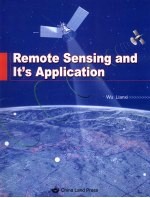

遥感及其应用PDF电子书下载
- 电子书积分:9 积分如何计算积分?
- 作 者:吴连喜著
- 出 版 社:北京:中国大地出版社
- 出版年份:2009
- ISBN:9787802462632
- 页数:158 页
1 Introduction 1
1.1 What is Remote Sensing 1
1.2 Electromagnetic Radiation 2
1.3 The Electromagnetic Spectrum 3
1.4 Interactions with the Atmosphere 5
1.5 Radiation-Target Interactions 7
1.6 Passive vs.Active Sensing 10
1.7 Characteristics of Images 10
2 Satellites and Sensors 14
2.1 On the Ground,In the Air,In Space 14
2.2 Satellite Characteristics:Orbits and Swaths 15
2.3 Spatial Resolution,Pixel Size,and Scale 17
2.4 Spectral Resolution 18
2.5 Radiometric Resolution 20
2.6 Temporal Resolution 20
2.7 Cameras and Aerial Photography 21
2.8 Multispectral Scanning 23
2.9 Thermal Imaging 25
2.10 Geometric Distortion in Imagery 26
2.11 Weather Satellites/Sensors 27
2.12 Land Observation Satellites/Sensors 30
2.13 Marine Observation Satellites/Sensors 36
2.14 Other Sensors 38
2.15 Data Reception,Transmission,and Processing 39
3 Microwave Remote Sensing 41
3.1 Microvaves Introduction 41
3.2 Radar Basics 43
3.3 Viewing Geometry and Spatial Resolution 44
3.4 Radar Image Distortions 47
3.5 Target Interaction and Image Appearance 49
3.6 Radar Image Properties 52
3.7 Advanced Radar Applications 55
3.8 Radar Polarimetry 57
3.9 Airborne versus Spaceborne Radars 60
3.10 Airborne and Spaceborne Radar Systems 61
4 Image Processing 64
4.1 Introduction 64
4.2 Digital Data 66
4.3 Elements of Visual Interpretation 68
4.4 Pre-Processing 69
4.5 Image Enhancement 72
4.5.1 Gray Scale Conversion 73
4.5.2 Histogram Conversion 74
4.5.3 Colour Display of Image Data 76
4.6 lmage Transform 78
4.6.1 Operations between Images 78
4.6.2 Principal Component Analysis 78
4.6.3 Tasseled Cap Transformation 79
4.7 Spatial Filtering 81
4.8 Texture Analysis 83
4.9 lmage Correlation 83
4.10 Image Fusion 85
4.10.1 Concept of Image Fusion 86
4.10.2 Objectives of Image Fusion 86
4.10.3 Image Fusion Techniques 89
4.10.4 Examples of Image Fusion 97
4.10.5 Advantages and limitations 99
4.11 Image Classification 103
4.11.1 Classification Techniques 103
4.11.2 Estimation of Population Statistics 105
4.11.3 Clustering 106
4.11.4 Parallelepiped Classifier 107
4.11.5 Decision Tree Classifier 108
4.11.6 Minimum Distance Classifier 109
4.11.7 Maximum Likelihood Classifier 111
4.11.8 Applications of Fuzzy Set Theory 112
4.11.9 Classification Using an Expert System 113
5 Applications 115
5.1 Agriculture 116
5.1.1 Crop Type Mapping 117
5.1.2 Crop Monitoring & Damage Assessment 119
5.1.3 Global Vegetation Map 121
5.2 Forestry 121
5.2.1 C1ear Cut Mapping & Deforestation 124
5.2.2 Species Identification & Typing 125
5.2.3 Burn Mapping 127
5.3 Hvdrology 128
5.3.1 Flood Delineation & Mapping 129
5.3.2 Soil Moisture 131
5.3.3 Water Quality Monitoring 132
5.4 Land Cover & Land Use 133
5.4.1 Land Cover Classification 135
5.4.2 Land Cover/Biomass Mapping 136
5.4.3 Land Cover Change Detection 137
5.5 Mapping 138
5.5.1 Planimetry 139
5.5.2 Height Measurement(DEM Generation) 140
5.5.3 Topographic & Baseline Thematic Mapping 141
5.5.4 Geological Interpretation 143
References 144
Appendix A Abbreviations and acronyms 149
Appendix B Colour Figure 151
- 《钒产业技术及应用》高峰,彭清静,华骏主编 2019
- 《现代水泥技术发展与应用论文集》天津水泥工业设计研究院有限公司编 2019
- 《英汉翻译理论的多维阐释及应用剖析》常瑞娟著 2019
- 《数据库技术与应用 Access 2010 微课版 第2版》刘卫国主编 2020
- 《区块链DAPP开发入门、代码实现、场景应用》李万胜著 2019
- 《虚拟流域环境理论技术研究与应用》冶运涛蒋云钟梁犁丽曹引等编著 2019
- 《当代翻译美学的理论诠释与应用解读》宁建庚著 2019
- 《第一性原理方法及应用》李青坤著 2019
- 《一带一路非洲东北部区生态环境遥感监测》俞乐 2019
- 《教师教育系列教材 心理学原理与应用 第2版 视频版》郑红,倪嘉波,刘亨荣编;陈冬梅责编 2020
- 《中风偏瘫 脑萎缩 痴呆 最新治疗原则与方法》孙作东著 2004
- 《水面舰艇编队作战运筹分析》谭安胜著 2009
- 《王蒙文集 新版 35 评点《红楼梦》 上》王蒙著 2020
- 《TED说话的力量 世界优秀演讲者的口才秘诀》(坦桑)阿卡什·P.卡里亚著 2019
- 《燕堂夜话》蒋忠和著 2019
- 《经久》静水边著 2019
- 《魔法销售台词》(美)埃尔默·惠勒著 2019
- 《微表情密码》(波)卡西亚·韦佐夫斯基,(波)帕特里克·韦佐夫斯基著 2019
- 《看书琐记与作文秘诀》鲁迅著 2019
- 《酒国》莫言著 2019
- 《中国当代乡土小说文库 本乡本土》(中国)刘玉堂 2019
- 《异质性条件下技术创新最优市场结构研究 以中国高技术产业为例》千慧雄 2019
- 《中国铁路人 第三届现实主义网络文学征文大赛一等奖》恒传录著 2019
- 《莼江曲谱 2 中国昆曲博物馆藏稀见昆剧手抄曲谱汇编之一》郭腊梅主编;孙伊婷副主编;孙文明,孙伊婷编委;中国昆曲博物馆编 2018
- 《中国制造业绿色供应链发展研究报告》中国电子信息产业发展研究院 2019
- 《中国陈设艺术史》赵囡囡著 2019
- 《指向核心素养 北京十一学校名师教学设计 英语 七年级 上 配人教版》周志英总主编 2019
- 《《走近科学》精选丛书 中国UFO悬案调查》郭之文 2019
- 《清至民国中国西北戏剧经典唱段汇辑 第8卷》孔令纪 2018
- 《北京生态环境保护》《北京环境保护丛书》编委会编著 2018
